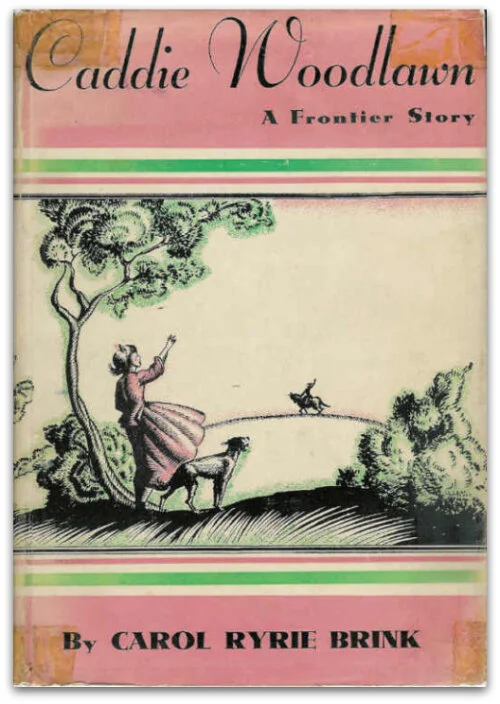Caddie Woodlawn (1936)
Pioneer stories in children’s literature are a recipe for disaster. I never got into the Little House on the Prairie books the same way my sisters did, but the cultural narratives were definitely a part of my childhood. There’s an excitement in the exploration of the unknown, the self-determination required to build your own house and find your own food, and the reward of making something appear on a blank canvas.
Unfortunately, the canvas wasn’t blank. I don’t need to go into much detail here, but westward expansion was really just the slow colonization of land that was already occupied by Native Americans, who’d been here for nearly ten thousand years (at least). From my childhood perspective, Indians were a thing to be feared—who knew when they’d show up out of nowhere and “massacree” your family? But history paints a disturbingly different story. The Encyclopedia of Indian Wars estimates that of all the frontier violence that took place from 1850-1890, 70% of the victims were Native Americans, many of them women and children.
In that historical context, pioneer books read a lot more like the tales of house thieves who break in, murder most of the occupants, and then start decorating. The wildest thing about Caddie Woodlawn is that this side of the narrative is made crystal clear. In one episode, there’s a rumor that the local tribes are planning a massacre of the white folks. The whole surrounding community comes to the Woodlawn’s home for protection and defense, and after a couple days of no action, Caddie overhears some men suggesting that they just go out and murder the Indians anyway, since it would be nice not to have to worry about them in the future.
In the book, Caddie ends up riding to (yikes) Indian John’s camp and warning the people to leave before her community kills them in cold blood. They end up leaving for safety, and Caddie’s dad rips the would-be murderers new assholes. Kinda cringey, but at least the episode ends with a moral lesson.
Alas, it also condemns the rest of the book. At nearly every other turn, Caddie Woodlawn is so exorbitantly offensive in its depictions of Native Americans that it’s enough to curdle your stomach. For the second time in this series, there are characters referred to as “the half-breeds”. (It would be another 37 years before Cher’s song of the same name went platinum, so I guess we still had a ways to go as a culture before people realized this was probably not okay.) “Indian John” is painted as childish and simplistic, except for the scalp-belt(!) he entrusts to Caddie, who quickly capitalizes on it and charges neighborhood children to come and touch it. White saviorism abounds any time there’s a nonwhite character on the page, so over-the-top and exaggerated that even the most ignorant of modern-day readers would still likely roll their eyes at it.
What’s especially frustrating about this is that, based upon that aforementioned incident of near-genocide, author Carol Ryrie Brink obviously knew better. By the 1930s, it was clear that Native Americans had much to fear from colonialism, and that settlers weren’t the ones who needed to fear for their lives. The US Government’s campaign against tribal sovereignty would heat up in a major way in the 1950s with the Indian Termination Acts, and the cultural campaign assimilate and erase the tribes would never really stop. It’s only been in very recent history that a sizable chunk of Americans have begun to take these issues seriously, but it’s too late to restore everything that was very violently lost.
If you haven’t guessed by now, Caddie Woodlawn really pissed me off. That’s not to say it’s all bad, though. Brinker was a hell of a writer, and more so than any other book so far, this one reads like it could have been written today. There’s also a sequel to the book entitled Magical Melons, which has to count for something. (If you’ve read it, I’d love to know A) what kind of melons they are, and B) what makes them magical.) Oh, and Caddie’s dog wanders hundreds of miles through the country to make it back to her in the end, which was sweet.
None of that really matters, though. Caddie Woodlawn is a mean-spirited, hurtful book that belongs in the garbage. Yuck.



